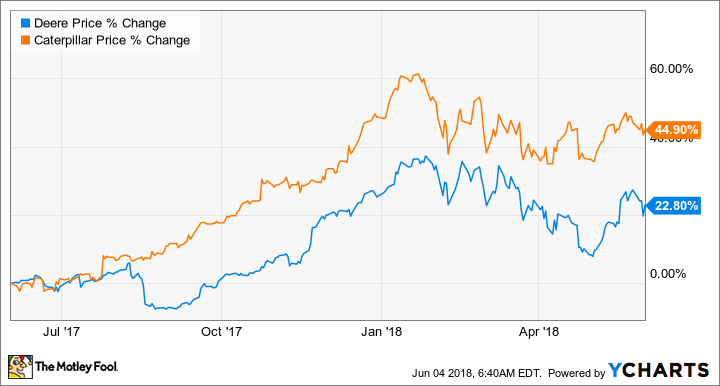Like its peer Caterpillar (CAT -0.55%), Deere & Company (DE -0.07%) has seen its stock decline in 2018. While end market conditions are improving and both companies raised guidance, the market has decided to take a dim view of their prospects. In Caterpillar's case, I think the market is overly worried by management's commentary on rising raw material prices, and a similar argument applies to Deere. Let's take a look at why it's time to get greedy with Deere stock.
3 reasons to like Deere's stock
As you can see in the chart above, it's been a good two months for both stocks, but they are both slightly down on a year-to-date basis at the time of this writing. In Deere's case, I want to present three arguments for why investors should still be optimistic:
- Deere's near-term end markets are clearly improving.
- Valuation remains attractive on a cyclically adjusted basis.
- Deere could have more upside from a potential rise in key crop prices.

Image source: Getty Images.
Improving end markets
Deere's key agriculture and construction end markets are clearly improving in 2018, and the company's recent second-quarter earnings report only served to confirm positive trends.
The agriculture and turf segment's profits (which accounted for 68% of total profits in the first six months) are forecast to increase 14% in 2018, compared to a 9% increase in 2017 -- but it's the composition of the revenue growth that really matters. For the first time in five years, Deere's agriculture machinery sales in the U.S. and Canada -- its core end markets -- are expected to increase. On the second-quarter earnings call, management maintained its guidance for a 10% increase in agriculture and turf sales growth in 2018. Deere started the year expecting 5%-10%.
Moreover, according to Brent Norwood, Deere's manager of investor communications, the increase is being driven by replacement demand: "Replacement demand continued to drive sales as customer cite the need for increased productivity, updated technology and equipment within its warranty period. "
In other words, the cyclical pick-up in demand isn't yet being driven by any improvement in crop prices or farmer income -- suggesting there is potential for more upside with any improvement in the prices of crops such as corn, wheat, soy, and cotton.
Deere's construction and forestry segment (13.7% of profits in the first half of the year) is also set for a strong 2018. Caterpillar increased its 2018 profit per share guidance by 24% in its first-quarter earnings presentation, and its construction industries segment is set for a particularly good 2018 -- sales are up 38% in the first-quarter. Meanwhile, Deere hiked its forecast for construction and forestry sales growth in 2018 to 83% from 80%.
Much of that growth will come from the Wirtgen acquisition. Nevertheless, even excluding Wirtgen and foreign currency movements, Deere's construction and forestry sales are expected to grow 26% in 2018 -- an improvement on the previously forecast 22% increase.
Valuation matters
There's no end to disagreements on how to value stocks and cyclical stocks like Deere in particular. Cyclical companies experience large peaks and troughs in their revenue and earnings, making them difficult to value.
DE Revenue (TTM) data by YCharts
One way to smooth out these differences is to calculate the 10-year average profit margin, and then apply this figure to revenue guidance in order to calculate normalized earnings.
Deere's 10-year average net income margin is 7.7%, and analysts are forecasting Deere's revenue to be $33.7 billion in 2018 and $36.2 billion in 2018. The table below shows the normalized P/E ratios created by using these figures. For reference, the current S&P 500 P/E ratio is 24.6, and Shiller's P/E Ratio (constructed using inflation-adjusted earnings from the last 10 years) is 32.2 -- so Deere's stock looks undervalued on a relative basis.
|
Deere & Company |
2018 |
2019 |
|---|---|---|
|
Forecast P/E Ratio |
16.1 |
13.2 |
|
P/E Normalized Ratio* |
19.1 |
17.7 |
Data source: Analyst forecasts, author's analysis. *Uses 10-year average Deere net income margin and analyst forecasts for revenue in 2018 & 2019
Upside from rising crop prices?
If you like Deere's valuation and near-term prospects, the stock also has further potential upside from rising crop prices. As noted above, Deere's agricultural machinery improvement is being driven by replacement demand, not by farmers' incomes improving as a result of crop prices increasing -- so current estimates look relatively safe even if they don't.
Crop prices are ultimately determined by a combination of factors, but the single most important variable is the weather. Given any adverse weather conditions that causes a smaller than expected harvest, crop prices could rise and increase farmers' income -- which is usually good news for Deere.
Time to buy Deere?
The long-term theme of growing food demand is an attractive one, and Deere looks set for strong demand from farmers replacing equipment. Throw in some potential upside from crop price increases and Deere's stock looks like a good value.







